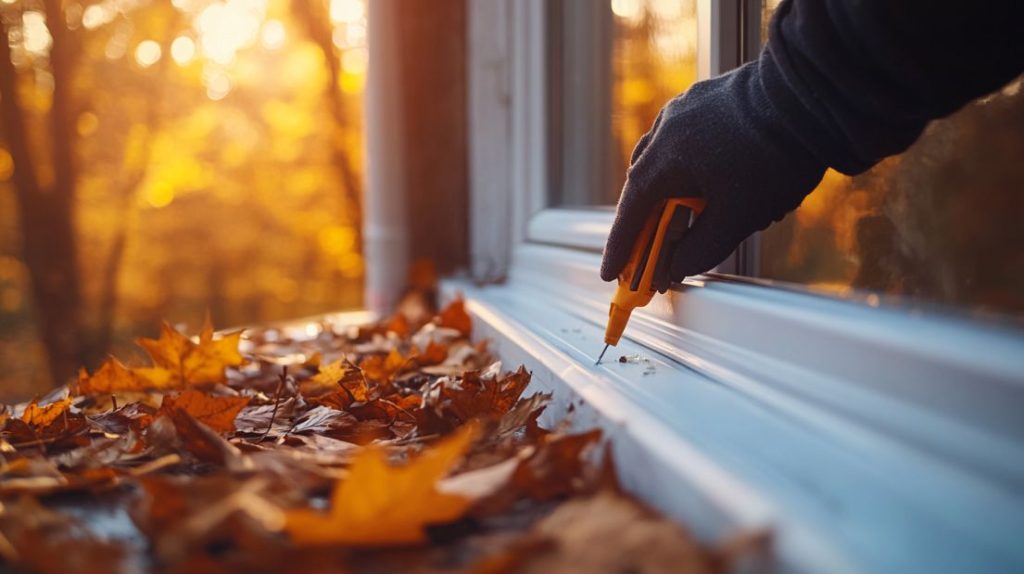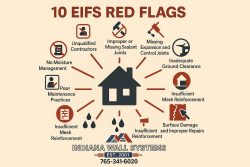Seal and Protect: A Guide to Exterior Caulks

When it comes to maintaining the exterior of your house, selecting the right caulking is crucial to ensuring the longevity and protection of your property. The exterior of your house is constantly exposed to the elements, all of which can cause damage over time if not properly sealed. Understanding what caulking to use on the exterior of your house is essential to protect against moisture intrusion, drafts, and energy loss. This comprehensive guide helps you learn what caulking to use on exterior of house, with their specific uses, and how to choose the best one for your exterior needs.
Understanding Caulking and Its Importance
Caulking plays a vital role in protecting your home from external elements by sealing gaps and joints between various building materials. This flexible material acts as a barrier, preventing water, air, dust, and insects from infiltrating your home, which is essential for preserving both the structural integrity and energy efficiency of the property.
Without proper caulking, moisture can seep into cracks and crevices, leading to severe issues like mold growth, wood rot, and even structural deterioration over time. These problems not only compromise the safety and stability of your home but also result in costly repairs.
Additionally, gaps that are not sealed correctly can allow drafts and heat loss, leading to increased energy consumption and higher utility bills. Regularly inspecting and maintaining the caulking around your home is a cost-effective way to prevent these issues, ensuring that your home remains secure, comfortable, and energy-efficient.
What Caulking to Use on Exterior of House: Common Types
Acrylic Latex Caulk
Acrylic latex caulk, often known as painter’s caulk, is a water-based caulking material that has become a staple in both interior and exterior home improvement projects. It is particularly favored for its ease of use, versatility, and affordability. This type of caulk is widely used for sealing gaps between different building materials, especially wood and other porous surfaces.
- Application and Benefits
One of the primary advantages of acrylic latex caulk is its ease of application. It is simple to work with, making it an ideal choice for DIY enthusiasts and professionals alike. The water-based formula allows for easy cleanup with soap and water, reducing the hassle of post-application maintenance. Once applied, acrylic latex caulk can be painted over, making it perfect for projects where aesthetics are a concern. It seamlessly blends with surrounding materials, ensuring a uniform appearance.
Acrylic latex caulk is particularly well-suited for sealing gaps in wood siding, around window and door frames, and where trim meets siding. Its flexibility allows it to accommodate slight movements in the materials it seals, reducing the risk of cracking over time.
- Limitations
While acrylic latex caulk is a versatile option, it does have some limitations. It is not as durable as some other caulking materials, especially in extreme weather conditions. Prolonged exposure to harsh sunlight, heavy rain, or freezing temperatures can cause the caulk to degrade more quickly than silicone or polyurethane options.
Additionally, while it offers some flexibility, it is not as elastic as silicone or polyurethane caulks, which can limit its effectiveness in areas prone to significant expansion and contraction.
- Best Uses
- Sealing joints in wood siding
- Around window and door frames
- Where trim meets siding
Silicone Caulk
Silicone caulk is renowned for its durability and flexibility, making it a top choice for exterior applications where long-lasting performance is required. Unlike acrylic latex caulk, silicone is not water-based, which gives it superior resistance to moisture, extreme temperatures, and UV radiation. This makes it ideal for areas that are constantly exposed to harsh environmental conditions.
- Application and Benefits
Silicone caulk is highly flexible, which means it can stretch and contract with the materials it is sealing, without cracking or breaking down. This flexibility is crucial in areas where temperature fluctuations cause expansion and contraction, such as around windows, doors, and roofing elements. Its strong adhesive properties ensure a tight bond with a variety of surfaces, including glass, metal, ceramic, and non-porous materials.
One of the standout features of silicone caulk is its longevity. Once cured, silicone caulk can last for decades without needing to be replaced, making it a cost-effective solution in the long run. It also maintains its elasticity over time, which is essential for preventing water and air infiltration.
- Limitations
Despite its many benefits, silicone caulk has some downsides. The most significant is its inability to be painted. Once applied, the caulk will remain its original color, which can be a disadvantage if color matching is important for your project.
Besides, silicone caulk can be more challenging to apply than other types of caulk. Its stickiness can make it difficult to work with, and it requires mineral spirits or a similar solvent for cleanup. These factors can make silicone caulk less user-friendly for beginners.
- Best Uses
- Around windows and doors
- In areas exposed to heavy rain or extreme temperatures
- Sealing gaps in glass, metal, and other non-porous materials
Polyurethane Caulk
Polyurethane caulk is a heavy-duty sealant that offers a unique combination of flexibility and strength. This caulking material is well-known for its exceptional adhesion to a wide range of surfaces, making it a go-to choice for exterior applications involving masonry, concrete, and metal. It is particularly valued for its durability and its ability to form a watertight seal.
- Application and Benefits
Polyurethane caulk is highly durable, providing a robust seal that is resistant to weathering, abrasion, and chemicals. It is also flexible, allowing it to move with the materials it bonds, which is essential in preventing cracks and leaks. This flexibility, combined with its strong adhesion, makes polyurethane caulk an excellent choice for sealing expansion joints in concrete, masonry, and metal structures. Unlike silicone, polyurethane caulk is paintable, which offers greater flexibility in terms of aesthetic integration into your home’s exterior.
Polyurethane caulk is particularly effective in areas that require a durable, long-lasting seal, such as around roof penetrations, flashing, and expansion joints. It is also an excellent choice for bonding dissimilar materials, thanks to its strong adhesive properties.
- Limitations
The primary drawback of polyurethane caulk is its application process. It can be more challenging to apply than other types of caulking, particularly for those who are not experienced. The material is thick and can be difficult to smooth out, which may result in a less polished finish.
Also, polyurethane caulk has a longer curing time compared to acrylic latex or silicone caulk. Depending on the specific product, it can take several days to fully cure, which may delay painting or other finishing work.
- Best Uses
- Sealing expansion joints in concrete and masonry
- Around roof penetrations and flashing
- Bonding dissimilar materials
Butyl Rubber Caulk
Butyl rubber caulk is a synthetic rubber compound known for its excellent adhesive properties and flexibility. It is particularly well-suited for applications where a long-lasting, waterproof seal is required, especially in areas exposed to significant movement or expansion and contraction due to temperature changes. Butyl rubber caulk is a popular choice for sealing around gutters, downspouts, and roof flashing.
- Application and Benefits
One of the key advantages of butyl rubber caulk is its superior adhesion to a wide variety of surfaces, including metal, glass, brick, and concrete. This makes it an excellent choice for sealing joints and seams in areas that are frequently exposed to water, such as around gutters and roof flashings. Butyl rubber caulk remains flexible over time, which is crucial for maintaining a tight seal in areas that experience regular movement.
Another significant benefit of butyl rubber caulk is its resistance to water. Once cured, it forms a watertight seal that prevents water from penetrating into the structure, protecting against leaks and water damage. This makes it an ideal choice for exterior applications where moisture protection is paramount.
- Limitations
The primary limitation of butyl rubber caulk is that it is not paintable. Once applied, the caulk will retain its original color, which can be a disadvantage if the aesthetic appearance is a concern.
Butyl rubber caulk can be more challenging to apply compared to other caulking materials. It has a thicker consistency, which can make it difficult to achieve a smooth finish. The caulk also has a longer curing time, which means it may take several days to fully set.
- Best Uses
- Sealing around gutters and downspouts
- Roof flashing
- Areas exposed to frequent movement and moisture
Hybrid Caulks
Hybrid caulks represent a newer generation of caulking materials that combine the best properties of silicone and polyurethane. These advanced sealants offer strong adhesion, flexibility, and durability, making them suitable for a wide range of exterior applications. Hybrid caulks are often more expensive than traditional caulking materials but provide superior performance and longevity.
- Application and Benefits
Hybrid caulks are designed to offer the best of both worlds— the flexibility and weather resistance of silicone, combined with the strong adhesion and paintability of polyurethane. This makes them an excellent choice for high-performance applications, particularly in areas that require a durable, long-lasting seal. Hybrid caulks can be used on a variety of surfaces, including wood, metal, glass, and masonry.
One of the key benefits of hybrid caulks is their ability to be painted, which allows them to blend seamlessly with the surrounding materials. This is a significant advantage over pure silicone caulks, which cannot be painted.
- Limitations
The primary downside of hybrid caulks is their cost. They are generally more expensive than traditional caulking materials, which may be a consideration for budget-conscious homeowners. Additionally, hybrid caulks may be harder to find in local hardware stores, as they are a relatively new product on the market.
- Best Uses
- High-performance applications
- Sealing around windows, doors, and exterior trim
- Areas exposed to harsh climates
Special Considerations for EIFS and Historic Homes
If your home features Exterior Insulation Finishing Systems (EIFS) or has historic plaster elements, choosing the right caulking becomes even more critical. EIFS requires careful attention to ensure the system remains watertight and free from cracks that could compromise its insulating properties.
Caulking for EIFS Systems
For EIFS, it’s essential to use caulking that is specifically designed for this type of system. A certified EIFS contractor should apply the caulking to ensure it meets manufacturer specifications and industry standards. The right caulking will adhere well to the EIFS surface and remain flexible to accommodate the natural movement of the system without cracking.
Best Options:
- Polyurethane caulk with EIFS-specific formulations
- Hybrid caulks designed for EIFS applications
How to Choose the Right Caulking for Your Project
Consider the Material
The type of material you’re sealing is a primary factor in choosing the right caulking. For example, silicone caulk works well on non-porous surfaces like glass and metal, while acrylic latex is better suited for wood and other porous materials. Polyurethane is versatile and can be used on various surfaces, including masonry and metal.
Evaluate the Climate
The weather conditions in your area play a significant role in determining the best caulking for your home. If your region experiences extreme temperatures or heavy rainfall, you’ll need a caulk that can withstand these conditions without degrading. Silicone and polyurethane caulks are generally more durable in harsh climates compared to acrylic latex.
Assess the Movement
If the area you’re sealing is subject to movement, such as expansion and contraction due to temperature changes, choose a flexible caulk like silicone or polyurethane. These materials can stretch and contract without cracking, ensuring a long-lasting seal.
Determine Paintability
If you plan to paint over the caulking, ensure you choose a paintable option. Acrylic latex and polyurethane caulks can be painted, while silicone typically cannot. If you need the durability of silicone but also require paintability, consider a hybrid caulk.
Budget Considerations
While it’s important to choose the best caulk for your needs, cost is always a consideration. Acrylic latex caulk is generally the most affordable, but it may not offer the same level of durability as silicone or polyurethane. On the other hand, hybrid caulks and specialized EIFS caulks may come at a higher price but offer superior performance and longevity.
The Importance of Proper Application
No matter which type of caulking you choose, proper application is key to ensuring its effectiveness. Here are some tips for achieving a professional-grade seal:
● Clean the Surface
Before applying caulk, ensure the surface is clean, dry, and free of debris. Any dirt, dust, or old caulk can prevent the new caulk from adhering properly.
● Use the Right Tools
A caulking gun is essential for applying caulk evenly. Look for a caulking gun with a smooth trigger action for better control. A caulk smoothing tool or a simple finger dipped in water can help you achieve a clean, smooth bead.
● Apply in the Right Conditions
Caulking should be applied when temperatures are between 40°F and 80°F. Extreme temperatures can affect the caulk’s ability to cure properly. Also, avoid applying caulk in wet conditions unless you’re using a caulk specifically designed for wet application.
● Allow Proper Curing Time
Different caulks have different curing times. Be sure to read the manufacturer’s instructions and allow the caulk to cure fully before exposing it to moisture or painting over it.
When to Hire a Professional
While many homeowners can handle basic caulking projects, certain situations may require professional expertise. If you’re dealing with an EIFS system, historic plaster, or large-scale projects, it’s best to hire a certified EIFS contractor or a professional plaster contractor. These experts have the knowledge and experience to ensure the job is done correctly, preserving the integrity of your home.
Maintaining Your Caulking
Caulking isn’t a set-it-and-forget-it solution. Regular maintenance is necessary to ensure your caulking remains effective over time. Inspect the caulking around your home at least once a year, especially after harsh weather conditions. Look for signs of cracking, shrinking, or peeling, and reapply caulking as needed to maintain a watertight seal.
Caulking Repair: When and How
Even the best caulking can degrade over time, requiring repair. Caulking repair involves removing the old caulk, cleaning the area, and applying a new bead of caulk. For extensive repairs or when dealing with EIFS or historic plaster, it’s advisable to consult with certified EIFS contractors or plaster contractors to ensure the repair is done correctly.
Certifications and Guarantees: Why They Matter
When hiring a contractor for your caulking needs, look for certifications and guarantees demonstrating their expertise and quality commitment. At Indiana Wall Systems, we proudly hold certifications such as BBB, Master Builders Cert, Senergy Certification, and EIFS Installers Certification.
These certifications ensure that our application methods are developed over decades with a key emphasis on strengthening typical problem areas, especially when dealing with EIFS applications. Our ten-year warranty is a testament to our confidence in the quality and durability of our work.
Protecting Your Home with the Right Caulking
Choosing the right caulking for your exterior house needs is a crucial step in maintaining your home’s structural integrity and appearance. Whether you’re sealing gaps in wood siding, protecting an EIFS system, or restoring historic plaster, the right caulk can make all the difference. By understanding the different types of caulking available and their specific uses, you can make an informed decision that will protect your home from the elements for years to come.
At Indiana Wall Systems, we are here to help you with all your caulking needs. Whether you need EIFS repair, historic plaster restoration, or general caulking services, our team of certified professionals is ready to assist.
Contact us today at (765) 341-6020 for a free estimate, and let us help you protect your home with our top-tier materials, expert methods, and unbeatable quality.



